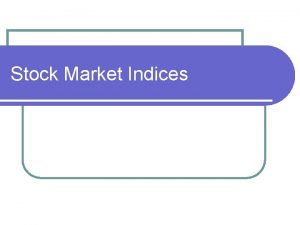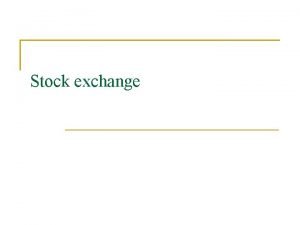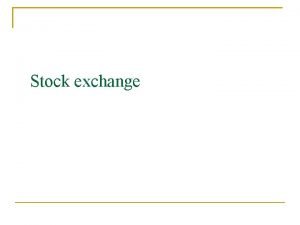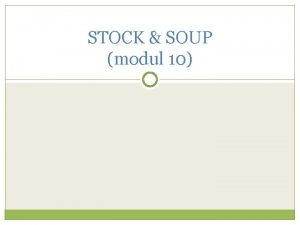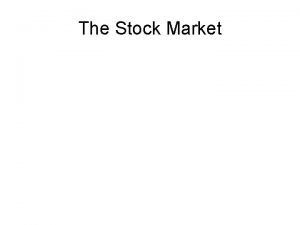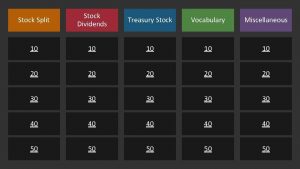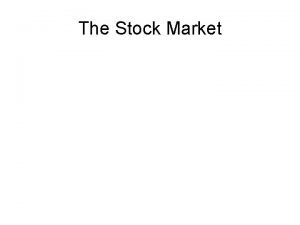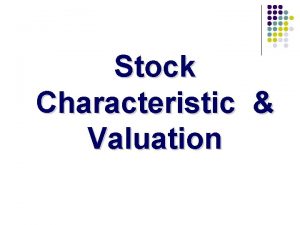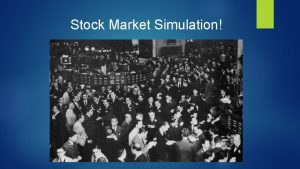OUTPERFORMING STOCK INDICES USING PROXIES FOR RISK AND
















- Slides: 16

OUTPERFORMING STOCK INDICES USING PROXIES FOR RISK AND RETURNS Vashishta Bhaskar Duquesne University Presented at QWAFAFEW September 9, 2014

Introduction n n Efficient markets Implications for investors Active equity portfolio management strategies Empirical results of sort by factor methodologies Expansion of existing quantitative techniques

Efficient Markets n n A market in which security prices rapidly reflect all available information Random walk (short term) Provide positive return (long term) Expected Returns are a function of Size, Relative Value (value-growth), Risk and Momentum

Implications for Investors and Money Managers n n n Risk tolerance Diversification Passive investing n n Buy & hold portfolios Indexing

Active Equity Investing n Fundamental Analysis n n Top-down Bottom-up Technical indicators Identify Attributes that provide superior returns

Empirical Results of Factor Based Strategies – Sort methodology n n Fama-French 1992 study concluded that small market equity portfolios performed better than large equity; And, higher book-to-market performed better than lower book-to-market.

Adapted from What Works on Wall Street. Size Effect 1952 -2003 Market Capitalization Return % Standard Deviation Sharpe Ratio <25 million 28. 12 47. 51 0. 63 25 million to <100 million 15. 96 30. 75 0. 46 100 million to <250 million 13. 72 24. 85 0. 46 250 million to < 500 million 13. 56 21. 46 0. 47 500 million to <1 billion 12. 18 19. 34 0. 44 >= 1 billion 11. 75 16. 98 0. 45 Market Leaders* 13. 52 17. 37 0. 54 Adapted from What Works on Wall Street pgs. 61 -62 *Market leaders defined as: non-utility, market cap > avg. , cf > avg. , sales > 50% of avg. from COMPUSTAT.

Returns: Russell Indices 2004 -2013 Summary Statistics - Russell. fld 12/1994 -12/2013 Standard N Maximum Ending Decline Index Arithmetic Geometric Deviatio Sharpe Positive Average Mean (%) Ratio Periods Decline (%) Value Russell 2000 TR 11. 07 9. 27 19. 67 0. 5627 13 -12. 87 -34. 82 58, 914 Russell 2500 TR 12. 61 10. 77 19. 69 0. 6405 16 -14. 53 -36. 79 77, 3430 Russell 1000 TR 11. 31 9. 38 19. 85 0. 5699 16 -37. 17 -37. 6 60, 0728

Returns by Cap 250 M – 1 B 1 B– 5 B and > 5 B. (1994 -2013) Standard N Average Maximum Arithmetic Geometric Deviation Sharpe Positive Decline Ending Mean (%) (%) Ratio Periods (%) Index Value Small Cap 10. 96 8. 86 21. 29 0. 515 13 -12. 65 -40. 62 54, 589 Mid Cap 12. 69 10. 86 19. 88 0. 638 14 -15. 33 -34. 89 78, 634 Large Cap 12. 55 10. 56 20 0. 6278 15 -34. 8 -40. 16 74, 458

High 100 CAPX and Low 100 CAPX Portfolio Returns by Cap Maximu m Standard N Ending Decline Index Arithmetic Geometric Deviation Sharpe Positive Average Mean (%) (%) Ratio Periods Decline (%) Value Small Cap High CAPX 100 28. 46 24. 08 34. 00 0. 8371 16 -14. 48 -41. 06 748, 374 Small Cap Low CAPX 100 5. 81 3. 22 22. 93 0. 2535 11 -27. 13 -53. 79 Mid Cap High CAPX 100 22. 76 19. 59 27. 51 0. 8272 17 -16. 1 -43. 51 358, 013 Mid Cap Low CAPX 100 8. 29 6. 35 19. 79 0. 419 12 -21. 28 -50. 47 Large Cap High CAPX 100 16. 41 14. 12 22. 61 0. 7259 15 -21. 12 -37. 36 140, 449 Large Cap Low CAPX 100 7. 84 5. 42 21. 36 0. 3671 14 -47. 34 -50. 46 18, 834 34, 250 28, 729

Small Cap High CAPX – Low CAPX Return Period End Dec 94 Dec 95 Dec 96 Dec 97 Dec 98 Dec 99 Dec 00 Dec 01 Dec 02 Dec 03 Dec 04 Dec 05 Dec 06 Dec 07 Dec 08 Dec 09 Dec 10 Dec 11 Dec 12 Dec 13 Small Cap High CAPX Small Cap Low CAPX High CAPX minus Low CAPX 1. 15% 30. 75% 34. 96% 39. 13% -7. 54% 31. 37% 34. 58% 11. 88% 0. 93% 73. 35% 50. 68% 28. 81% 38. 40% 22. 16% -41. 06% 118. 92% 48. 88% -5. 97% 7. 33% 54. 90% -10. 68% 28. 12% 19. 93% 17. 16% -15. 00% 35. 98% -16. 65% -6. 28% -18. 60% 43. 32% 8. 80% -4. 81% 11. 36% -15. 04% -45. 61% 29. 06% 13. 89% -15. 53% 18. 62% 30. 89% 11. 83% 2. 63% 15. 03% 21. 98% 7. 45% -4. 62% 51. 23% 18. 16% 19. 53% 30. 03% 41. 89% 33. 63% 27. 05% 37. 20% 4. 55% 89. 86% 34. 98% 9. 56% -11. 29% 24. 01%

Why Z – Score? n n Expected return from Corporate Bonds = Risk free rate + bond risk premium Expected Return from Equity = Company specific bond rate + equity risk premium Z score model and calculation provided at the end of this presenation

50 Stock portfolios based on high and low Z scores Standard N Maximum Arithmetic Geometric Deviation Sharpe Positive Average Decline Ending Index Mean (%) (%) Ratio Periods Decline (%) Value (%) Small Cap High CAPX High Z 50 32. 75 27. 96 37. 55 0. 8721 15 -10. 22 -35. 88 1, 385, 930 Small Cap High CAPX Low Z 50 24. 67 20. 12 32. 98 0. 7483 15 -16. 27 -45. 14 391, 135 Mid Cap High CAPX High Z 50 29. 78 26. 07 32. 19 0. 9251 19 -37. 01 1, 028, 754 Mid Cap High CAPX Low Z 50 15. 14 12. 32 25. 06 0. 6043 14 -15. 11 -43. 97 102, 201 Large Cap High CAPX High Z 50 18. 33 16. 04 22. 21 0. 8254 15 -18. 53 -39. 14 195, 975 Large Cap High CAPX Low Z 50 14. 51 11. 85 25. 46 0. 5698 14 -22. 75 -36. 85 93, 915. 37

Z Score effects Return thru Dec 94 Dec 95 Dec 96 Dec 97 Dec 98 Dec 99 Dec 00 Dec 01 Dec 02 Dec 03 Dec 04 Dec 05 Dec 06 Dec 07 Dec 08 Dec 09 Dec 10 Dec 11 Dec 12 Dec 13 Small Cap High CAPX High Z 50 Small Cap High CAPX Low Z 50 High z - Low Z 6. 09% 29. 86% 36. 03% 46. 46% -5. 06% 49. 14% 37. 11% 24. 80% -4. 86% 67. 24% 52. 48% 31. 38% 50. 60% 21. 41% -35. 88% 147. 21% 53. 78% -1. 97% 12. 29% 46. 29% -2. 43% 35. 64% 34. 08% 30. 49% -15. 39% 23. 78% 44. 47% -2. 36% 5. 39% 69. 87% 50. 29% 21. 57% 32. 26% 27. 10% -45. 14% 91. 94% 38. 82% -15. 11% 0. 04% 69. 09% 8. 52% -5. 78% 1. 95% 15. 96% 10. 33% 25. 37% -7. 36% 27. 16% -10. 25% -2. 63% 2. 19% 9. 81% 18. 34% -5. 69% 9. 26% 55. 27% 14. 96% 13. 14% 12. 24% -22. 80%

Summary Statistics - 12/1994 -12/2013 Arithmetic Mean (%) Geometric Mean (%) Standard Deviation (%) Sharpe Ratio N Positive Periods N Negative Periods Average Decline (%) Maximum Decline (%) Starting Index = 10. , 000 Ending Index Value Large Cap 12. 55 10. 56 20. 00 0. 6278 15 5 -34. 80 -40. 16 74, 458. 7836 Large Cap High CAPX 100 16. 41 14. 12 22. 61 0. 7259 15 5 -21. 12 -37. 36 140, 448. 9883 Large Cap High CAPX High Z 50 18. 33 16. 04 22. 21 0. 8254 15 5 -18. 53 -39. 14 195, 975. 8426 Large Cap High CAPX Low Z 50 14. 51 11. 85 25. 46 0. 5698 14 6 -22. 75 -36. 85 93, 915. 3658 Large Cap Low CAPX 100 7. 84 5. 42 21. 36 0. 3671 14 6 -47. 34 -50. 46 28, 728. 8504 Mid Cap 12. 69 10. 86 19. 88 0. 6380 14 6 -15. 33 -34. 89 78, 634. 6707 Mid Cap High CAPX 100 22. 76 19. 59 27. 51 0. 8272 17 3 -16. 10 -43. 51 358, 013. 2837 Mid Cap High CAPX High Z 50 29. 78 26. 07 32. 19 0. 9251 19 1 -37. 01 1, 028, 754. 4758 Mid Cap High CAPX Low Z 50 15. 14 12. 32 25. 06 0. 6043 14 6 -15. 11 -43. 97 102, 201. 3356 Mid Cap Low CAPX 100 8. 29 6. 35 19. 79 0. 4190 12 8 -21. 28 -50. 47 34, 250. 1741 Small Cap 10. 96 8. 86 21. 29 0. 5150 13 7 -12. 65 -40. 62 54, 589. 6128 Small Cap High Capx 100 28. 46 24. 08 34. 00 0. 8371 16 4 -14. 48 -41. 06 748, 374. 3280 Small Cap High CAPX High Z 50 32. 75 27. 96 37. 55 0. 8721 15 5 -10. 22 -35. 88 1, 385, 930. 5502 Small Cap High CAPX Low Z 50 24. 67 20. 12 32. 98 0. 7483 15 5 -16. 27 -45. 14 391, 135. 1867 Small Cap Low CAPX 100 5. 81 3. 22 22. 93 0. 2535 11 9 -27. 13 -53. 79 18, 833. 9723

Limited conclusions and further research n n CAPX is indicative of future returns Z score can be used as a further discriminant as a proxy for risk There additional factors such as value and momentum that can be incorporated in an overall strategy Scaled CAPX or items such as retention ratio may be useful
 C++ static reflection
C++ static reflection Paleoclimate proxies
Paleoclimate proxies Options on stock indices and currencies
Options on stock indices and currencies Market risk credit risk operational risk
Market risk credit risk operational risk Features of preferred stock
Features of preferred stock Preferred stock characteristics
Preferred stock characteristics Teknik pengolahan makanan dalam pembuatan stock adalah
Teknik pengolahan makanan dalam pembuatan stock adalah Stock final de marchandises
Stock final de marchandises Residual risk and secondary risk pmp
Residual risk and secondary risk pmp Business vs financial risk
Business vs financial risk Relative risk
Relative risk Relative risk
Relative risk Using risk to balance agile and plan driven methods
Using risk to balance agile and plan driven methods Iso 22301 utbildning
Iso 22301 utbildning Typiska drag för en novell
Typiska drag för en novell Tack för att ni lyssnade bild
Tack för att ni lyssnade bild Vad står k.r.å.k.a.n för
Vad står k.r.å.k.a.n för

















